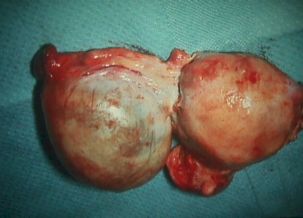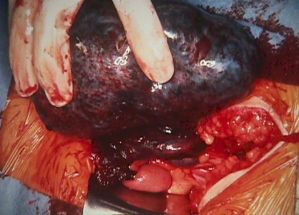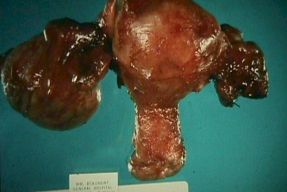Adnexal Masses - Clinical
Patients with adnexal masses may present with pain, bleeding, or other troublesome symptom. Most of these masses will be benign and largely
self-resolving, while a few are dangerous or life-threatening.
Simple Ovarian Cysts
An ovarian cyst is a fluid-filled sac arising from the ovary. Ovarian cysts can be broadly categorized as having two origins: physiologic cysts as a consequence of ovulation (or atttempted ovulation), and neoplastic cysts. Of the two, ovulation-related cysts are by far the more common
Functional cysts are common and generally cause no trouble. Each time a woman ovulates, she forms a small ovarian cyst (3.0 cm in diameter or less). Depending on where she is in her menstrual cycle, you may find such a small ovarian follicular cyst.
|
|
Unruptured Ovarian Cyst
While most of these have no symptoms, they can cause pain, particularly with strenuous exercise or intercourse. Treatment is symptomatic with rest for those with significant pain. The cyst usually ruptures within a month. Once ruptured, symptoms will gradually subside and no further treatment is necessary. If it doesn't rupture spontaneously, surgery is sometimes performed to remove it. This will relieve the symptoms and prevent torsion
Ruptured Ovarian Cyst
This is an ovarian cyst that has ruptured and spilled its' contents into the abdominal cavity. If the cyst is small, its' rupture usually occurs unnoticed. If large, or if there is associated bleeding from the torn edges of the cyst, then cyst rupture can be accompanied by pain. The pain is initially one-sided and then spreads to the entire pelvis. If there is a large enough spill of fluid or blood, the patient will complain of right shoulder tip pain. Symptoms should resolve with rest alone. Rarely, surgery is necessary to stop continuing bleeding.
Torsioned Ovarian Cyst
A torsioned ovarian cyst occurs when the cyst twists on its' vascular stalk, disrupting its' blood supply. The cyst and ovary (and often a portion of the fallopian tube) die and necrose. Patients with this problem complain of severe unilateral pain with signs of peritonitis (rebound tenderness, rigidity). This problem is often indistinguishable clinically from a pelvic abscess or appendicitis.
Treatment is surgery to remove the necrotic adnexa. Mortality rates from this condition (without surgery) are in the range of 20% due to metabolic acidosis resulting from the tissue necrosisTorsioned Ovarian Cyst
<a name="Endometrioma">
</a>Endometrioma
|
Back to obstetrics homepage


